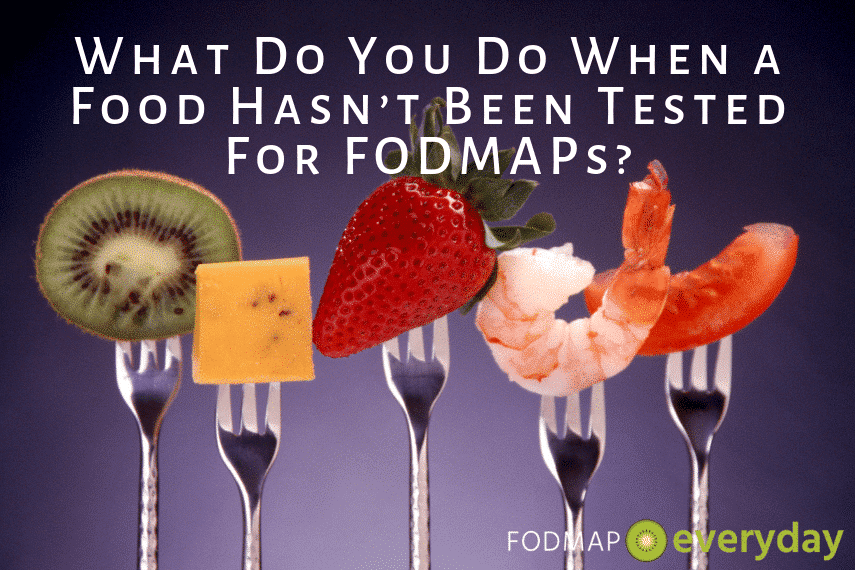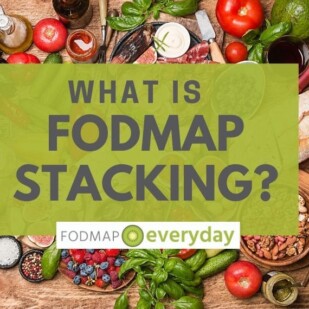We are huge proponents of using the Monash University Low FODMAP Smartphone App and FODMAP Friendly Smartphone App for looking up certified low FODMAP foods and individual ingredients, but what if a food hasn’t been lab tested for FODMAPs and is not in the apps?
Want to know if you can eat broccoli and if so, how much? Have a question about a bread or sauce that has the Monash University or FODMAP Friendly logo on it?
The answers to all of these questions and many more will be at your fingertips within the smartphone apps.
But what happens if you want to eat a food that hasn’t been lab-tested for FODMAPs? What do you do?

We’ve got good news for you; there is a solution.
Lab Tests vs. Your GI Tract
When a prepared food product or a raw ingredient is lab-tested for FODMAPs, the testing certifiers (Monash University or FODMAP Friendly) report the findings on their websites and on their smartphone apps so that we can all benefit from the information.
(Please read our companion article, How To Read A Low FODMAP Certified Food Product Label).
But here is the kicker – you are not a lab.
The reports are of FODMAP levels of foods as detected in a lab setting. In the best-case scenario we are given a Low FODMAP level, a Moderate as well as a High FODMAP level, but we are not always given such complete information for every entry.
When we develop Elimination Phase friendly recipes (and you will know which these are by seeing our “kiwi icon” ), we use the lab tested low FODMAP levels per serving as our markers. READ ABOUT OUR RECIPE FILTER HERE.
This is to assure you, that as far as science can guide us, that the recipe will be “low FODMAP”.
You Are Not a Lab
BUT, and this is a huge BUT, since you are not a lab, you may very well react to a recipe or a certified food product, even if it is deemed low FODMAP and built upon low FODMAP ingredients (and even taking stacking into consideration during meals).
Your Individual Tolerance Is The Most Important Thing
How you react to a singular ingredient, prepared product or a recipe (made up of multiple ingredients) will be unique to you. And you will only know by trying that food. That’s why whether a food has been lab-tested for FODMAPs or not is not the most important thing.
Your reaction to the food is.
You can read more in our article, What Is A Low FODMAP Serving Size?
If you follow well-structured Elimination and Challenge Phases you will come out of those stages of the diet with a clear understanding of your own needs and tolerances.
This information can guide you in making food choices. Look at it as your foundation for beginning to eat a broader diet by integrating this newfound knowledge into everyday food choices.
If you react to a food that has been declared “low FODMAP”, all that matters is that you know this fact and make adjustments for your own health and comfort in the future.
If you react to a food that has been declared “low FODMAP”, all that matters is that you know this fact and make adjustments for your own health and comfort in the future.
If the food hasn’t been lab-tested, you now have your own unique answer in reference to how this food works with your GI system. If the food has been tested, it doesn’t necessarily mean that the food product was mislabeled or the lab testing was faulty. Either way, it just means that that food is not for you!
Luckily, since IBS is a “functional” GI disorder, as truly uncomfortable and in pain we might be if we trigger our symptoms, we are not dealing with a life and death situation. We will recover. And we can make sure not to eat that food again anytime soon.
Tolerances Are Not Static
Notice that I said “anytime soon”. This doesn’t necessarily mean forever. Our bodies are living systems and our tolerances can change. This is one reason why at FODMAP Everyday® we call the second stage of the diet the Challenge Phase and not the “re-challenge” or “re-introduction” phase, as you might sometime see.
This is because there might very well be a time when you DO “re-challenge”, but that will be a subsequent time.
Let me explain another way: Let’s say you Challenge garlic and you do okay with half a clove but when you get to a whole clove, you trigger symptoms. You then know your garlic limit – FOR NOW.
Six months from now, or a year from now, you could “re-challenge” with that whole clove of garlic and might very well be able to tolerate it – or maybe you find you are still symptom-free at half a clove. No one can know how you will react.
You have to re-test on yourself, which is something to consider doing, because tolerances can and do change, positively or negatively, for many people.
…tolerances can and do change, positively or negatively…
If there is a particular food that you miss, it is a great idea to “re-challenge” because you might be able to add it back into your diet in more liberal amounts.
This of course goes for foods that are tested or untested, but especially with un-tested foods since you will not have any baselines to judge against.
The Takeaway
As always, we recommend that you work through the Elimination and Challenge Phases with a FODMAP trained Registered Dietitian. The low FODMAP diet, and your symptoms, can be nuanced and you will have the best chance of success working with a medical professional – particularly a RD.
Please read our article, The Role Of The Dietitian vs. The Gastroenterologist.
And, in the end, it doesn’t matter what any chart or smartphone listing says. If you discover that a food triggers IBS symptoms for you, pay attention to your body.







